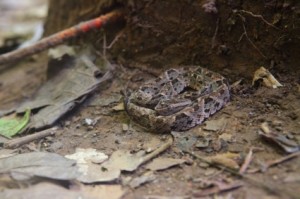
A juvenile fer de lance in Corcovado National Park. Photo © Christopher P. Baker.
Want a good laugh? Then watch me hike the rainforest trails of Costa Rica alone. I look like a blind man tapping his way forward with a long stick in front of me, probing the leaf litter for venomous snakes.Specifically, the fearsome fer-de-lance.
The thought of stepping on a Bothrops asper, king of the deadly tropical vipers, sends shivers down my spine.
So well-camouflaged is the “ultimate pit viper” that on a recent National Geographic Expeditions 7-day “Costa Rica & Panama Canal” trip, sixteen trip participants filed past a fer-de-lance on the San Pedrillo Waterfall Trail, in Corcovado National Park. No-one—not even our eagle-eyed naturalist guide at the front of the line—saw it until I spotted it, coiled up just inches from where I was about to tread. I was bringing up the rear.
Amazing!
True enough, it was only a juvenile measuring perhaps 18 inches long, uncoiled. But young fer-de-lance, which Costa Ricans call the terciopelo (velvet) for its velvety skin, are as potentially deadly as their full-grown parents. Adult females (the species is dimorphic, with females considerably larger than males) can reach a sobering length of 8 feet. (Adults regulate the amount of venom they inject; youngsters typically give you everything they’ve got.)
It seemed remarkable that the snake hadn’t struck at the 16 pairs of feet traipsing past literally inches from its head. It was actually on the path, hard up against a fallen tree-trunk.
The fer-de-lance is no shrinking violet. This snake species is renowned for its propensity to strike first and ask questions later.
Peter Aspinall, owner of Tiskita Lodge at Pavones (on the Pacific Southwest coast, near Panama), once told me about how he was walking his dog one day in the rainforest. The hound disturbed a full-grown terciopelo, which took off toward a stream.
The excitable and fast-moving fer-de-lance is easily distinguished by its disproportionally large, broad, V-shaped head, flat on top and tipped like a spear at the nose.Costa Rica’s rural folk have no love for this species, which accounts for half of all snake bikes (and almost all the fatal ones) in Costa Rica; herpetologist Douglas March was killed by a fer-de-lance. Thus, Peter, who was born in Costa Rica, raced after it.As he raised his machete, the snake suddenly turned and with vicious speed struck at Peter, who tumbled backwards into the stream. His machete had come down hard on the snake as he fell, breaking its spine. Peter scrambled to regain his composure, then he dispatched the snake. Its head—the size of a coffee mug—is pickled in a jar for viewing at Tiskita Lodge.
The excitable and fast-moving fer-de-lance is easily distinguished by its disproportionally large, broad, V-shaped head, flat on top and tipped like a spear at the nose. It lives below 4,000 feet elevation in Costa Rica (but ranges from eastern Mexico to Venezuela) and prefers moist habitats, especially rainforests. It is also found in the tropical deciduous forests of northwest Costa Rica. In all cases, it’s extremely difficult to spot, as its patterned skin in multiple shades of brown blends in perfectly with the leaf litter.
An ambush snake, it uses its highly-sensitive heat-detecting pit organ to detect prey. It’s also nocturnal, which perhaps explains the somnolent response of the juvenile we encountered as 16 people trudged past on January 18 on the trail in Corcovado.
Now you understand why Costa Rica’s campesinos (peasants and country workers) wear tall rubber boots. In all cases, wear hiking boots that cover the ankles whenever you’re hiking the forest trails.